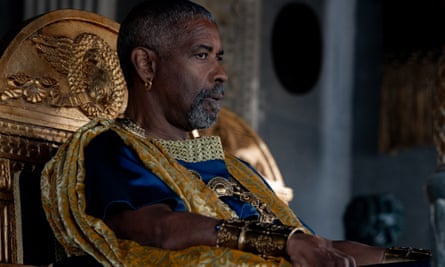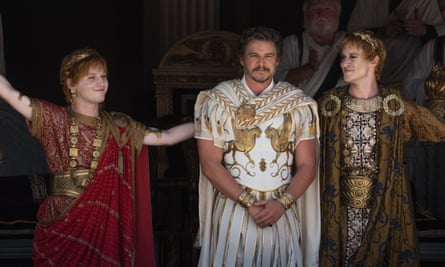Does accuracy in a movie set in the past actually matter? When one historian pointed out errors in Ridley Scott’s Napoleon, the director brusquely told him to “get a life”. But sifting fact from fiction, and plausible plotline from sheer fantasy, is part of the fun of watching a historical movie. Sorry, Ridley: you are as likely to stem the tide of incoming pedantry on Gladiator II as successfully defend yourself in combat against a troop of (implausibly) bloodthirsty baboons.
For weeks before Gladiator II opened, its trailer was already the subject of historical-accuracy scrutiny. In fact, the main culprit therein was not so much a matter of historical error as a crime against common sense: no, rhinos cannot be tamed, broken and ridden like horses. Could the Colosseum really be filled with water and made the scene of a mock sea battle?
Actually, that one is moot. Supposedly, the opening of the Colosseum in AD80 involved such an event, but it seems more likely that such extravaganzas would have been staged at another, more suitable location. Nothing about the remains of the building suggests that it was capable of being flooded and kept watertight. One thing is for sure, though: rich Romans may have done all kinds of things with elaborate seawater ponds (the magnate Crassus famously kept a pet eel and supposedly wept when it died), but harvesting and inserting man-killing sharks into the aforementioned mock sea battles was beyond them.
 View image in fullscreen
View image in fullscreen
Five minutes for a trailer: two-and-a-half hours for the entire movie. It’s hard to know where to begin when presented with the full, lavish, epic spread of historical inaccuracy offered by Gladiator II. One of the funniest moments is offered by Denzel Washington’s Macrinus (yes, a real person from Mauretania, but not a former slave – and he did eventually succeed Caracalla as emperor). At one point, this wonderfully camp creation is seen evilly sipping what appears to be a cup of coffee (not around for another millennium or so) or tea (China only at this point) at a cafe (there weren’t any) while reading the morning paper (again, only China was producing paper, and, naturally, nothing approaching a newspaper).
The gladiatorial games themselves: there’s a wonderful bit in Gladiator II when all hell breaks loose in the crowd as well as in the arena. It’s great to watch. But Roman historians Mary Beard and Keith Hopkins, in their book The Colosseum, think the baying horde of repute is a myth: the real crowd might have been rather more like, they suggest, audiences for modern opera, with a good deal less gladiatorial blood spilled than in the movies. (To be fair, I’ve seen crowds at the Royal Opera House baying for blood, but not yet actually rioting.)
As for Caracalla, played as an enjoyably crazed sybarite by Fred Hechinger, he really was the Roman emperor, and yes, he really did reign jointly with his brother Geta – but only briefly until the former had the latter killed. (By the way, syphilis is hinted at in Gladiator II – it is unlikely to have arrived in Europe much before 1495’s great pox epidemic, although its origins are a matter of debate.) In Scott’s film, the sibling emperors are quite peculiar creations – somewhere between Johnny Rotten, the Harkonnens from the original Dune, and the most effete figures you could find in a Lawrence Alma-Tadema painting, their snivelling effeminacy troublingly set against the masculine virtues of Paul Mescal’s gladiator. They are pale and red-headed, though in real life the sons of a Libya-born father, Septimius Severus, and a Syrian mother, Julia Domna. (In other ways, the film is rightly invested in emphasising the diversity of Roman life, its people drawn from across the Mediterranean world.)
 View image in fullscreen
View image in fullscreen
The real Caracalla was a bearded, tough-looking warrior, probably eye-liner free, who barely touched down in Rome, spending most of his reign at war and/or massacring people. He funded the building of an enormous baths complex in Rome and, significantly, passed a law making free men across the entire empire citizens. He lasted a good 19 years at the helm before his assassination. His mother, Julia Domna, is one of the most recognisable women of the Roman empire, thanks to a very distinctive hairdo of horizontal, helmet-like waves, immortalised in sculpture, coins, pottery and the famous “Berlin tondo”.
The last is a rare painting that shows her, her husband and their children. The face of Geta was scratched out after his removal from the throne, just as his name was obliterated from inscriptions across the empire. Various Roman sources have Julia Domna wielding significant power in Rome. Exactly the sort of scenario that might possibly have provided an interesting plotline …
And that, unfortunately, is part of the point. Gladiator I is a classic film for many reasons: one of them, its great plot. I don’t believe for a second that Marcus Aurelius was secretly conspiring to reintroduce the Roman republic – but the idea worked as a plotline for the film not least because there really was a stream of Roman thought that looked wistfully back at the “good old days” before one-man rule. Gladiator II is a kind of wonky redrawing of Gladiator I, tacked awkwardly over the template of its predecessor.
Because it’s so determined to follow the earlier film’s beats, quite soon, nothing about it makes much sense. Poor Paul Mescal is doing wonderful work with his fight scenes, but otherwise struggles with a character whose motivations don’t seem to add up. You can overlook a lot of historical nonsense if the story is forcefully dragging you along with it; when it’s not, doubts about everything else rush in.
My pedant’s expectations were lifted in the first few minutes, when Mescal utters a real quote from the author Tacitus. (“They make a desert and call it peace” – a resonant phrase attributed by the historian to the Caledonian leader Calgacus, albeit in a different historical period.) After that it’s downhill for me, at least. Go see Gladiator II for the menacing rhinos, the severed limbs spurting blood (if that’s your thing) and the fabulous crowd scenes. For a great movie: stick to Gladiator I.
Charlotte Higgins is the Guardian’s chief culture writer
